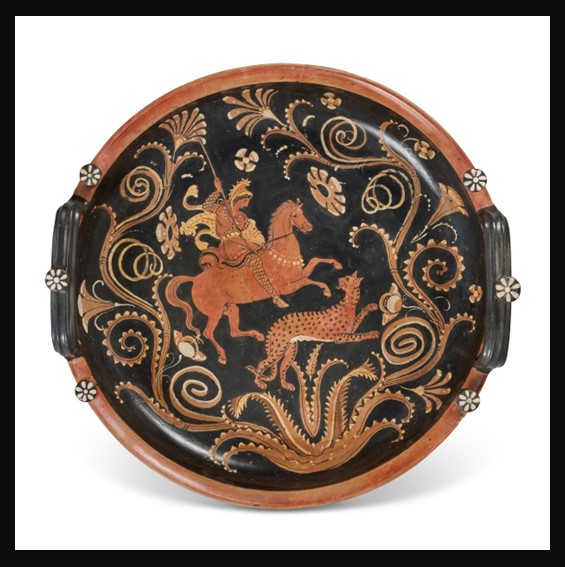
The ancient Apulian Pottery Style, originating in southeastern Italy during the 4th to 3rd centuries BCE, is renowned for its distinctive and ornate red-figure technique. Characterized by elaborate scenes and mythological narratives, Apulian pottery often featured detailed depictions of figures in dynamic poses, showcasing a high level of artistic skill and storytelling. The vessels, ranging from amphorae to kraters to paterae, served both functional and decorative purposes, with intricate designs adorning their surfaces. Artists employed a rich colour palette, including red, white, and yellow, creating a visually striking contrast. The subjects depicted in Apulian pottery varied widely, encompassing mythology, daily life, and religious themes. This unique pottery style not only reflects the artistic achievements of ancient Apulia but also provides valuable insights into the cultural and social context of the time.
In July 2023, at Christie’s, an Apulian Red-Figured Knob-Handled Patera, dating back to the second half of the 4th century BC and executed in the style of the Lycurgus Painter, was auctioned with exceptional results. The patera’s interior features an Amazon on horseback, adorned in an intricate costume and panther skin, wielding a long spear while attacking a panther amidst a complex freeform foliate setting. Conversely, the exterior is decorated with a central figure of winged Eros, flanked by draped females on one side, and a centrally seated draped female, accompanied by winged Eros and another draped female, on the opposite side. This exquisite piece of pottery provides us with the opportunity to raise questions about Apulian Pottery and its significance… https://www.christies.com/lot/lot-6436519?ldp_breadcrumb=back&intObjectID=6436519&from=salessummary&lid=1
What was the cultural and historical context of ancient Apulia during the production of the so-called, Apulian Pottery? Apulia, a region in Southern Italy colonized by the Greeks, played a significant role in the production of pottery during the 4th century BC. Over half of the recovered pottery vases from Southern Italy, particularly in modern Puglia, were crafted in Tarentum, a major Greek polis in the area. This flourishing pottery production was part of the broader phenomenon of Greek colonization in the western Mediterranean, occurring from the 8th to the 5th century BC, leading to the establishment of colonies in Southern Italy and Sicily, collectively known as Magna Graecia or ‘Great Greece.’ The influx of Greek artisans and pottery makers to these colonies facilitated the development of a unique artistic style that blended local Italic traditions with Attic aesthetics.
What is an ‘Apulian Patera’… The term ‘Apulian Patera’ typically refers to a specific shape of ancient Apulian pottery rather than a separate style. A patera is a shallow, often bowl-like vessel with a flat, wide rim. In the context of Apulian pottery, the Apulian Patera shape is commonly associated with the red-figure pottery produced in Apulia during the 4th to 3rd centuries BC. These vessels were characterized by their distinctive form, featuring a broad, flat rim with a slightly concave interior. The exterior of the bowl often displayed intricate red-figure decorations, showcasing scenes from mythology, daily life, or religious motifs. The Apulian Patera shape was popular for various functions, including serving food and libations during rituals or symposia. The artistic embellishments on these vessels, coupled with their functional design, make Apulian Patera potter an intriguing aspect of ancient Apulian artistic and cultural heritage.
How would Apulian Pottery aesthetics be described… Apulian pottery vessels exhibit distinctive aesthetic characteristics that contribute to their enduring appeal. Renowned for their red-figure technique, these vessels typically feature a lustrous black background adorned with intricate, finely drawn details in red, white, and occasionally yellow pigments. The scenes depicted on Apulian pottery often showcase a remarkable level of artistry, with figures engaged in dynamic poses and elaborate narratives drawn from mythology, daily life, or religious themes. The artists displayed keen attention to anatomical accuracy and fine details, emphasizing the expressive facial features and fluid movement of the depicted figures. The wide range of vessel shapes, including kraters, amphorae, and the characteristic Apulian Patera, further highlight the versatility of this pottery tradition. The overall effect is one of visual richness and storytelling, where each vessel becomes a canvas for the skilled artisans to convey both aesthetic beauty and cultural narratives from ancient Apulia.
For a PowerPoint of 10 Masterpieces of Apulian Pottery, please… Check HERE!